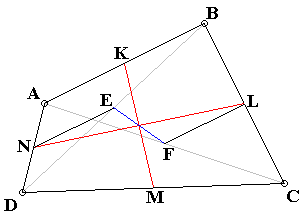Bimedians in a Quadrilateral
What is this about?
A Mathematical Droodle
| What if applet does not run? |
|Activities| |Contact| |Front page| |Contents| |Geometry|
Copyright © 1996-2018 Alexander Bogomolny
The applet illustrates the following statement:
In any quadrilateral, the lines joining the midpoints of the diagonals and those of the opposite sides are concurrent.
Indeed, from ΔABD, NE||AB and
A similar argument applies to the quadrilateral EKFM. Since EF has only one midpoint, this is shared by the three lines.
It thus follows that the three lines EF, KM, and LN are concurrent and each is bisected by their common point. The three lines are known as the bimedians of the quadrilateral (and sometimes just medians), so that the statement could be formulated as
The three bimedians of any quadrilateral meet in a point by which they are divided in the ratio 1:1.
[F. G.-M., p. 50] notes that the problem was first posed and later solved in the first volume (1810-11) of the Annales de Gergonne.
The statement just proven admits a simple mechanical interpretation. Indeed, the point of intersection of the medians is nothing but the barycenter -- the center of gravity -- of a system of four equal weights (or material points) placed at the vertices of the quadrilateral. The statement just says that there are three ways to obtain the barycenter. The weights could be first combined two by two, which is possible in three ways, with the resulting 2-point system combined into a single point on the second step [Honsberger, p. 40, Wells, p. 161].
The median EF -- the line joining the midpoints of the diagonals of a quadrlateral -- is also known as its Newton's line [F. G.-M., p. 767]. The line appears in a theorem by Léon Anne and has significance for inscriptible quadrilaterals.
References
- C. Alsina, R. B. Nelsen, Charming Proofs, MAA, 2010, p. 108
- F. G.-M., Exercices de Géométrie, Jacques Gabay, 1991
- R. Honsberger, Episodes in Nineteenth and Twentieth Century Euclidean Geometry, MAA, 1995
- C. W. Trigg, Mathematical Quickies, Dover, 1985, #198
- D. Wells, You Are a Mathematician, John Wiley & Sons, 1995
Barycenter and Barycentric Coordinates
- 3D Quadrilateral - a Coffin Problem
- Barycentric Coordinates
- Barycentric Coordinates: a Tool
- Barycentric Coordinates and Geometric Probability
- Ceva's Theorem
- Determinants, Area, and Barycentric Coordinates
- Maxwell Theorem via the Center of Gravity
- Bimedians in a Quadrilateral
- Simultaneous Generalization of the Theorems of Ceva and Menelaus
- Three glasses puzzle
- Van Obel Theorem and Barycentric Coordinates
- 1961 IMO, Problem 4. An exercise in barycentric coordinates
- Centroids in Polygon
- Center of Gravity and Motion of Material Points
- Isotomic Reciprocity
- An Affine Property of Barycenter
- Problem in Direct Similarity
- Circles in Barycentric Coordinates
- Barycenter of Cevian Triangle
- Concurrent Chords in a Circle, Equally Inclined
|Activities| |Contact| |Front page| |Contents| |Geometry|
Copyright © 1996-2018 Alexander Bogomolny73579702
